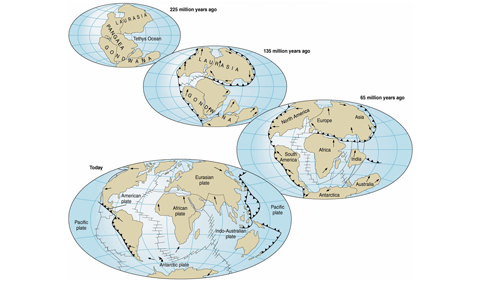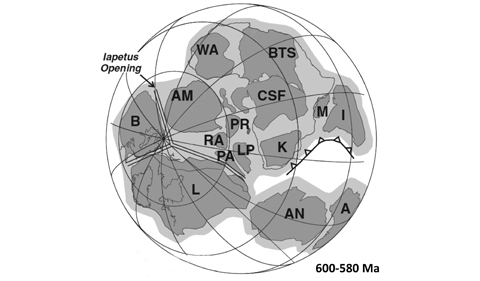
Dr. Damian Nance
Ohio University geologist Dr. Damian Nance identifies evidence for Pannotia, a supercontinent predating Pangea, by examining the patterns of worldwide mountain building and rifting as the Earth’s land masses collide and break up, along with accompanying destruction and creation of climates and habitats in the wake of those tectonic changes.
Many people have heard of Pangea, the supercontinent that formed some 300 million years ago and later broke up as the modern Atlantic and Indian oceans opened. But according to the “supercontinent cycle,” rather than being Earth’s only supercontinent, Pangea was just the most recent of a whole series of supercontinents that have punctuated geologic time for billions of years—shaping and reshaping the Earth’s oceans and land masses as its oceans, atmosphere and biosphere evolved.
The supercontinent cycle was first proposed in the early 1980s by Nance, Distinguished Professor of Geological Sciences, and Ohio University colleague Tom Worsley.
Today, the cycle is also thought to be the dominant influence on the circulation of the Earth’s mantle, to the point of fundamentally affecting the behavior of the Earth’s magnetic field.

Figure 1: Continental reconstructions showing the breakup history of the supercontinent Pangea over the past 225 million years.
Based on the data available at the time, Nance and Worsley proposed the existence of five pre-Pangean supercontinents, four of which have since been named. But while much has been made of the supercontinent Rodinia, which came together about 1100 million years ago, and the supercontinent Columbia, which broke up some 400 million years earlier, disagreement reigns over the existence of the most recent pre-Pangean supercontinent, Pannotia, which Nance and Worsley argued came into existence about 600 million years ago.

Figure 2: One reconstruction of Pannotia as it existed 580 to 600 million years ago. Major continental components: A=Australia, AM=Amazonia (South America), AN=Antarctica, B=Baltica (Europe), BTS and CSF=portions of South America and North Africa, I=India, K=Kalahari (South Africa), L=Laurentia (North America), M=Madagascar, WA=West Africa. Siberia is not shown.
Direct evidence for the existence of past supercontinents depends on continental reconstructions based heavily on data from two fields, that of paleomagnetism, which can be used to constrain the past positions of continents, and that of age dating, which constrains the timing of events. But when applied to Pannotia, it is unclear from these data alone whether the supercontinent ever came together or had time to do so. The data are permissive but cannot be used to demonstrate the supercontinent’s existence.
However, in a paper titled “Supercontinents and the case for Pannotia” recently published by the Geological Society of London, Nance and his Canadian colleague Brendan Murphy argue that the recognition of past supercontinents need not rely solely on continental reconstructions, but also can exploit a variety of phenomena that accompany their assembly and breakup. For example, supercontinent assembly is accompanied by worldwide mountain building as the continents collide, just as evidence of continental rifting will accompany supercontinent breakup. Similarly, supercontinent assembly fosters extinctions as surface conditions change and habitats are destroyed, whereas breakup fosters radiations as new habitats are created.
Supercontinents also affect the world’s sea level, ocean chemistry and climate in predictable ways and produce an array of isotopic signals that can be identified in rocks. When the geologic record is examined for evidence of these accompanying phenomena, the case for Pannotia is unmistakable, they argue. The time interval encompassed by the assembly and breakup of Pannotia was accompanied by some of the most profound changes in Earth history, changes that were heralded by widespread mountain building, followed by global evidence of continental breakup, and affected the Earth’s oceans, atmosphere, biosphere and climate just as predicted.
These signals, Nance and Murphy caution, argue strongly for the existence of Pannotia, and to ignore them and dismiss this supercontinent is to potentially overlook the profound changes in mantle circulation that likewise accompany the assembly and breakup stages of the supercontinent cycle.
Abstract: Disagreement about the existence of the late Neoproterozoic supercontinent Pannotia highlights the limitation of defining supercontinents simply on the basis of size, which, for pre-Pangaean supercontinents, is difficult to determine. In the context of the supercontinent cycle, however, supercontinent assembly and break-up, respectively, mark the end of one cycle and the beginning of the next and can be recognized by the tectonic, climatic and biogeochemical trends that accompany them. Hence supercontinents need only be large enough to influence mantle circulation in such a way as to enable the cycle to repeat. Their recognition need not rely solely on continental reconstructions, but can also exploit a variety of secular trends that accompany their amalgamation and break-up. Although the palaeogeographical and age constraints for the existence of Pannotia remain equivocal, the proxy signals of supercontinent assembly and break-up in the late Neoproterozoic are unmistakable. These signals cannot be readily attributed to either the break-up of Rodinia or the assembly of Gondwana without ignoring either the assembly phase of Pan-African orogenesis and the changes in mantle circulation that accompany this phase, or the reality that Gondwana cannot be a supercontinent in the context of the supercontinent cycle because its break-up coincides with that of Pangaea.


















Comments